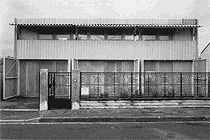
|
Sixth Vienna Architecture Congress Where will we live? Our societies are beginning to change their habitual views of home. However, our old ideas of home have not yet been replaced by new ones able to offer an answer to the question: Where will we live? Many agree that nothing seems able to stem the process of dematerialization and dehistorization in today’s worlds. May we be living in times in which even the "figures" and "images" of architecture are unable to supply a sufficient answer? The problem is deep-seated: Is the home, that form of built, designed and social construction now at the mercy of the qualitatively new reality of reprivatization and deregulation? Is it responsible for the fracturing of all accustomed public, political, creative regulation fantasies? In many countries, also in the western world, there is at least growing concern about the decline of concepts such as "belonging" and "home." Irrational fears are on the loose. For instance, the fear of the seemingly uncontrollable innovations of the displaced. The banishment of people who no longer fulfill the standards of normality has become commonplace, just as the poverty cycle of living in the favelas. Many of these negative, fear-ridden reactions grow in direct interaction with a certain utopian fury of speculation about the redeeming and revolutionary power of architectural images. Architecture has become part of cultural industry. In the meantime, the planners have obviously recognized their limited scope for political action, to be administered in various model housing developments as liberal antidote against social disease. And the new networks of information, imagery, stylistic production, and power no longer fit onto drawing paper as complyingly as before. That is why it appears so urgent to probe after the way this process co-builds the notions of new living and how the dweller’s world of living is shaped by the supply economy of present-day housing projects. The question weighs heavily: How to avoid the pitfalls of old functionalistic or phenomenological, organist or typological, sociological conception of housing policies? How can architecture continue to work within these frames? Can it attempt to pull them down in order to obtain new terms and images that become inscribed in the rapidly changing social conditions? Meanwhile, not only the theme park residences built by prominent developer forces are giving their sometimes cynical signals. In any case, architecture is still developing its own images: Highly artificial, symbolically charged late-era versions of the villa-type building co-exist with the creative effort to develop models for the minimum standards of living. The attempt at ecologically sustainable building within the limits of the extensive cut-price production of residential buildings, as practiced in the metropolises of South-East Asia, stands in stark contrast to projects developing from the fear inherent to European cities of being unable to cope with new labor conditions, the cutback of social benefits, and inner-European migration. Precisely because urban theoreticians set great store by the metaphors of density and materiality in order to master the future tasks of urban building and architecture, the work of architects itself should be grasped as a form of theoretical activity answering this question: It is an inherent, ever-day form of theory, one that directly traces the texture of economic, medial, and social practices. Perhaps today, architecture does not provide an answer to the question "Where will we live?" posed by the Architecture Congress in Vienna, whether meant politically, socially or creatively, but instead the way in which this question is posed and dealt with, should be lived with and already is being lived? The 6th Viennese Architecture Congress intends to initiate a critical and historical survey to analyze the residence issue in the many cultural strata it involves: urban planning and architecture, private images of life and media, technology and building industry, economy and the changing working world. At the same time, the study of how we will live is an investigation of both the contemporary obsession with imaging and media and their diagnostic analysis, as a type of "attack of interdisciplinarity against existing architectural structures." The rapid development of housing industry can not only be seen pessimistically as the economy’s conspiracy against architecture with the aim to capture people in the next stage of consumer capitalism. It is also an opportunity. An opportunity to assign sectors, currently always newly defined - social segregation and the division of labor into public and private, cultural, and economic, unemployed and employed domains, into spheres allocated to nationals and foreigners, men and women. That is why the congress wants to withstand the temptation of restricting this bundle of questions to only economic and planning issues. How will we live? The interest lies in illustrating the issue as lively as possible, inevitably depending on actual examples, images, scenes, technologies, and social formations. This question should not be thought of in terms of what has been achieved, but instead in terms of constant transitions - even if and perhaps precisely because it lacks a framing, architectural binding character. |
 |
|
|
|
Press page Current events Past events Dates: Sixth Vienna Architecture Congress Information: Ines Purtauf Tel.: +43 (1) 522 31 15 - 25 Fax: +43 (1) 522 31 17 Email: purtauf@azw.at |
| © Architekturzentrum Wien 2025 |
||



